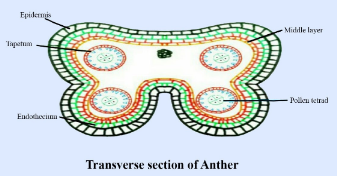Answer
345.6k+ views
Hint: Microsporangium is a sac-like structure consisting of microspores which form pollen grains. Microsporangium is divided into the microsporangium wall and sporogenous tissue in which microsporangium wall is divided into the epidermis, endothecium, middle layer and tapetum.
Complete answer:

Microsporangium of an Angiosperm
The anther of an angiosperm is generally bilobed in a structure which consists of microsporangium. This microsporangium consists of microsporangia which divide to form pollen grains. The microsporangium consists of four wall layers outside and sporogenous tissue inside. The microsporangium wall is divided into outer layer epidermis, hypodermal wall layer endothecium, middle layer and innermost nourishing layer tapetum. Tapetum is the innermost layer consisting of a dense cytoplasm which after endomitosis becomes enlarged in size and multinucleate. The tapetum cell performs various functions like it provides nourishment to the developing sporogenous tissue, microspore mother cell and microspore. It helps in the binding of microspore, by the production of enzymes callose. It secretes ubisch granules which provide a covering to the pollen grains. It provides a covering to entomophilous pollen grain with the help of pollenkitt, which is adhesive, provides odour which helps to attract insects. It also provides protein which helps to find out compatible and incompatible pollen grains. It also releases enzymes, hormones, amino acids, etc during microsporogenesis which help in the development of young pollen.
Note:
The ubisch bodies of pollen grains are also known as orbicules. It occurs in different shapes and is made up of lipids. It does not perform specific functions but acts as a by-product of tapetal cell metabolism. In some cases, ubisch bodies help in the lysis of tapetal cells.
Complete answer:

Microsporangium of an Angiosperm
The anther of an angiosperm is generally bilobed in a structure which consists of microsporangium. This microsporangium consists of microsporangia which divide to form pollen grains. The microsporangium consists of four wall layers outside and sporogenous tissue inside. The microsporangium wall is divided into outer layer epidermis, hypodermal wall layer endothecium, middle layer and innermost nourishing layer tapetum. Tapetum is the innermost layer consisting of a dense cytoplasm which after endomitosis becomes enlarged in size and multinucleate. The tapetum cell performs various functions like it provides nourishment to the developing sporogenous tissue, microspore mother cell and microspore. It helps in the binding of microspore, by the production of enzymes callose. It secretes ubisch granules which provide a covering to the pollen grains. It provides a covering to entomophilous pollen grain with the help of pollenkitt, which is adhesive, provides odour which helps to attract insects. It also provides protein which helps to find out compatible and incompatible pollen grains. It also releases enzymes, hormones, amino acids, etc during microsporogenesis which help in the development of young pollen.
Note:
The ubisch bodies of pollen grains are also known as orbicules. It occurs in different shapes and is made up of lipids. It does not perform specific functions but acts as a by-product of tapetal cell metabolism. In some cases, ubisch bodies help in the lysis of tapetal cells.
Recently Updated Pages
How do you arrange NH4 + BF3 H2O C2H2 in increasing class 11 chemistry CBSE

Is H mCT and q mCT the same thing If so which is more class 11 chemistry CBSE

What are the possible quantum number for the last outermost class 11 chemistry CBSE

Is C2 paramagnetic or diamagnetic class 11 chemistry CBSE

What happens when entropy reaches maximum class 11 chemistry JEE_Main

Calculate the volume occupied by 88 gram of CO2 at class 11 chemistry CBSE

Trending doubts
Difference Between Plant Cell and Animal Cell

Difference between Prokaryotic cell and Eukaryotic class 11 biology CBSE

Fill the blanks with the suitable prepositions 1 The class 9 english CBSE

Change the following sentences into negative and interrogative class 10 english CBSE

How many millions make a billion class 6 maths CBSE

Fill the blanks with proper collective nouns 1 A of class 10 english CBSE

Give 10 examples for herbs , shrubs , climbers , creepers

What organs are located on the left side of your body class 11 biology CBSE

What is BLO What is the full form of BLO class 8 social science CBSE



